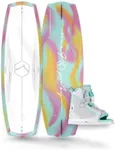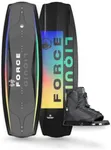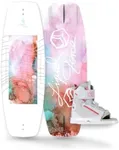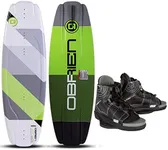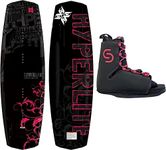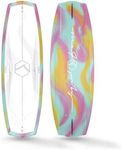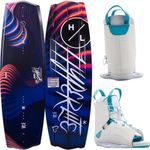Buying Guide for the Best Women's Wakeboards
Choosing the right wakeboard can significantly enhance your experience on the water. When selecting a wakeboard, it's important to consider various factors that will affect your performance and enjoyment. These factors include the board's size, shape, rocker type, and other features. Understanding these specifications will help you make an informed decision and find a wakeboard that suits your skill level, riding style, and personal preferences.Board SizeThe size of the wakeboard is crucial because it affects your stability and control on the water. Wakeboards come in different lengths, typically measured in centimeters. A longer board provides more stability and is easier to ride for beginners, while a shorter board offers more maneuverability and is preferred by advanced riders. To choose the right size, consider your weight and skill level. Beginners should opt for a longer board within the recommended weight range, while more experienced riders can choose a shorter board for better tricks and agility.
Rocker TypeThe rocker type refers to the curvature of the wakeboard from tip to tail. There are three main types: continuous, three-stage, and hybrid. A continuous rocker has a smooth, consistent curve, providing a fast and predictable ride, ideal for beginners and those who enjoy carving. A three-stage rocker has distinct flat spots, offering more pop off the wake for jumps and tricks, suitable for intermediate to advanced riders. A hybrid rocker combines elements of both, providing a balance of speed and pop. Choose a rocker type based on your riding style and skill level.
Board ShapeThe shape of the wakeboard affects how it moves through the water and responds to your movements. There are two main shapes: continuous and three-stage. Continuous boards have a smooth, curved shape that allows for a faster and smoother ride, making them great for carving and cruising. Three-stage boards have a more angular shape, providing more lift and pop for jumps and tricks. Beginners may prefer a continuous shape for its ease of use, while more advanced riders might opt for a three-stage shape to enhance their performance on tricks.
FinsFins are small attachments on the bottom of the wakeboard that help with stability and control. They come in different sizes and shapes, and can be removable or molded into the board. Larger fins provide more stability and are helpful for beginners, while smaller fins offer more freedom for advanced tricks. Some boards have removable fins, allowing you to customize your ride based on your skill level and the type of water conditions. Consider your experience and the type of riding you plan to do when choosing the fin setup.
FlexFlex refers to how much the wakeboard bends under pressure. A stiffer board provides more control and is better for carving and high-speed riding, making it suitable for more experienced riders. A more flexible board offers a softer, more forgiving ride, which is ideal for beginners and those who enjoy a more relaxed riding style. When choosing the flex, think about your skill level and the type of riding you enjoy. Beginners may benefit from a more flexible board, while advanced riders might prefer a stiffer board for better performance.
BindingsBindings are the boots that attach your feet to the wakeboard. They are crucial for comfort and control. Bindings come in different styles, including open-toe and closed-toe. Open-toe bindings are more adjustable and can accommodate a range of foot sizes, making them a good choice for beginners or those who share their board. Closed-toe bindings offer a more secure fit and better performance, preferred by advanced riders. When choosing bindings, consider the fit, comfort, and support they provide, as well as your skill level and riding style.
